Debate: Military significance of Dresden
The justification of the Bombing of Dresden relies heavily, as any bombing should, on the military significance of the intended target. There are several specific aspects of Dresden that are Debated regarding their military significance; these include the strategic location of Dresden, the rail system in Dresden, and war related industry.
The rail systems in Dresden are debated as a key aspect that would make Dresden a militarily significant target, hence helping to justify its destruction.
The rail systems in Dresden are debated as a key aspect that would make Dresden a militarily significant target, hence helping to justify its destruction.
In the above military map of WWII Germany (from February 16th 1945) shows that Dresden (circled) is in fact a crossroads for the rail system.
"Extensive traffic structures changed the appearance of the city: additional bridges over the Elbe, new railway lines and stations and an Elbe port were built." [7]
This quote from modern day Dresden's official website confirms that the establishment of rail systems was a part of Dresden's growth.
In addition to having a substantial rail system, Dresden was also home to a number of industries, some war related.
"Dresden grew rapidly in the decades following 1850. The industrial branches which have become typical for the city, such as precision engineering, optics, luxury foods (chocolate) and cigarettes, were established." [7]
Most of the industries listed above are war related in some way. Precision engineering could have been related to weapon design or manufacture. Optics would have been related to the manufacture of weapon sights. Among these optics manufactures was said to be Zeiss Ikon A.G., Germany's most important optical goods manufactory. [9]
According at a USAF historical site Dresden was home to a large number of war industries.
"Dresden was, in February 1945, known to contain at least 110 factories and industrial enterprises that were legitimate military targets," [9]
With Russian troops advancing from the East, Dresden posed a threat.
"Marshal Koniev’s armies were less than seventy miles east of Dresden and by virtue of their extended positions highly vulnerable to German counterattack, provided the Germans could pass reinforcements through Dresden." [9]
Russian advance is shown in image in the right hand column.
Debate Sections:
Introduction
The bombing of Civilians
The destruction of a historic city
Other Sections:
Consequences
Introduction
The bombing of Civilians
The destruction of a historic city
Other Sections:
Consequences



